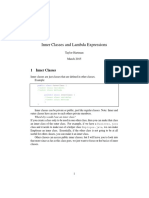0% found this document useful (0 votes)
33K views16 pagesFunction: Makecounter Var Count
The document discusses JavaScript closures and scope. Key points include:
1) Closure is when a function retains access to variables in its parent scope even after the parent function has returned. This allows inner functions to access variables in the parent function's scope.
2) Functions create closures which retain variable bindings for referenced variables even after the parent function has closed. This allows functions defined within other functions to access variables from the parent function's scope.
3) Closures are useful for encapsulating related data and functions together while maintaining access to shared variables. Common uses include counters, private variables, and object-oriented inheritance patterns in JavaScript.
Uploaded by
Watan SahuCopyright
© © All Rights Reserved
We take content rights seriously. If you suspect this is your content, claim it here.
Available Formats
Download as PDF, TXT or read online on Scribd
0% found this document useful (0 votes)
33K views16 pagesFunction: Makecounter Var Count
The document discusses JavaScript closures and scope. Key points include:
1) Closure is when a function retains access to variables in its parent scope even after the parent function has returned. This allows inner functions to access variables in the parent function's scope.
2) Functions create closures which retain variable bindings for referenced variables even after the parent function has closed. This allows functions defined within other functions to access variables from the parent function's scope.
3) Closures are useful for encapsulating related data and functions together while maintaining access to shared variables. Common uses include counters, private variables, and object-oriented inheritance patterns in JavaScript.
Uploaded by
Watan SahuCopyright
© © All Rights Reserved
We take content rights seriously. If you suspect this is your content, claim it here.
Available Formats
Download as PDF, TXT or read online on Scribd
/ 16










































































































